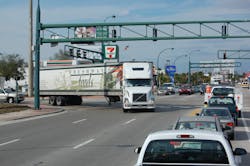Shipper/Carrier collaboration key to capacity and cost control
One of the major trends highlighted at FTR’s annual Transportation Conference last week is how shipper/carrier collaboration will only increase as it remains one of the last ways both parties can control both capacity and costs in the years ahead.
“Carriers have largely exhausted the ways they can save money,” explained Noel Perry, FTR’s senior consultant and president of research firm Transport Fundamentals. “Equipment is not getting cheaper, they must pay drivers more, and unprecedented regulatory growth is increasing their cost of operations. The only thing left to them is what’s beyond their direct control: interactions with the shipper.”
He believes that the shipper with access to capacity at a reasonable cost is going to be the “big winner” down the road, as failures to get goods to market on time will have “huge” implications.
“That’s why we’re only at the beginning of harvesting the fruits of better relationships between carriers and shippers,” Perry pointed out as those “better relationships” offer a huge opportunity “to change the way we operate trucks” in the U.S.
For example, as FTR estimates that changes to hours of service (HOS) rules made back on July 1 alone resulted in a 3% loss of trucking productivity nationwide, how carriers and shippers collaborate going forward will determine how much an impact future regulations have on the industry’s capability, he said.
For example, Perry emphasized that while great strides in fuel economy occurred over the last two decades – since 1993, the TL sector’s fuel efficiency has jumped up 8.9%, he noted – overall trucking costs , including higher equipment prices, rising driver pay scales, fuel costs, and regulatory costs, jumped 4% in the early 2000s and 8% between 2010-2011. While costs were flat in 2012-2013, FTR is forecasting a 2% to 3% spike for 2014.
“That’s why better management of capacity is the key,” Perry explained. So while truck capacity has been tight the last two years, it’s been stable, thus allowing shippers and carriers to work successfully with what’s available. “But there is also no surge capacity left in the industry,” he added.
“Capacity has been tight but predictable due to the pace of growth in this moderate [economic] recovery,” added Jim Tucker, president & COO of freight brokerage firm the Tucker Company. “That’s why we really haven’t seen a capacity crunch. Yet capacity tightness means shippers need to lower expectations; same-day pickups and service, for example, are tough to handle now. We need more lead times.”
Time, stressed Tucker, is really the key advantage of better shipper/carrier collaboration. “The more lead times we have, the more chances we have to optimize inbound and outbound freight moves via shared information, the more tremendous efficiencies become available,” he explained. “Better synching shipper and carrier schedules together is what enables this.”
“Improved efficiency is offsetting the cost of regulations – such as higher driver pay and technology investments – for us,” noted John Vesco, executive vice president with drayage firm Comtrak. “’But the problem is we’re running out of ways to gain more efficiencies.”
Jon Meier, vice president of agricultural conglomerate Cargill, made added that his company is actively working to help its carriers get more lead times so they in turn can be more productive and offer more capacity. “But we’re preparing for that inevitable crunch,” he said.
About the Author
Sean Kilcarr
Editor in Chief
Sean Kilcarr is a former longtime FleetOwner senior editor who wrote for the publication from 2000 to 2018. He served as editor-in-chief from 2017 to 2018.
